Pillowcases with ears have an alternative name - "Oxford". To sew such a model with your own hands, you need to know how to choose the right fabric, how much material to buy and how to make a pattern. Step-by-step descriptions of sewing pillowcases of different sizes will help beginner seamstresses.
Choosing fabric for sewing pillowcases
The fabric for pillowcases should be selected in accordance with their purpose. If it is a pillowcase for a pillow intended for sleeping, the material should be soft and pleasant to the touch. Synthetic fabrics that tend to become electrified are not suitable. The material should absorb moisture well, since people often sweat in their sleep.
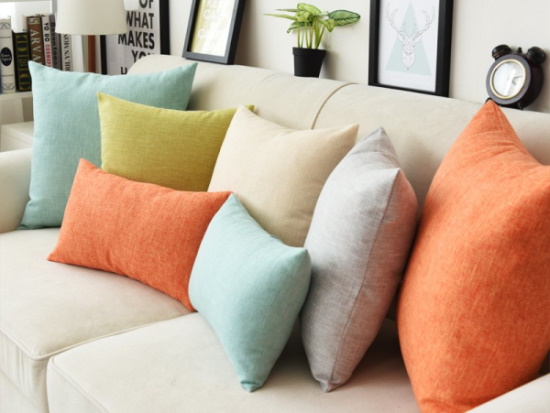
Dense, "non-breathing" fabrics can cause inflammation on the face if used for a long time. You can buy calico for bed linen. It is inexpensive, lightweight, absorbs moisture well and lets air through.
Most often, such fabric has a delicate coloring of pastel tones with small floral patterns. Calico is easy to cut, the edges do not crumble, the fabric almost does not wrinkle. This material has only 1 drawback - after 20 washes, the color fades, and after 1 year, the material loses strength and begins to tear. A more durable analogue of calico is calico. It will last longer and will not lose its rich color after repeated washings. Calico does not wrinkle, and folds that appear as a result of long-term storage are easy to smooth out.
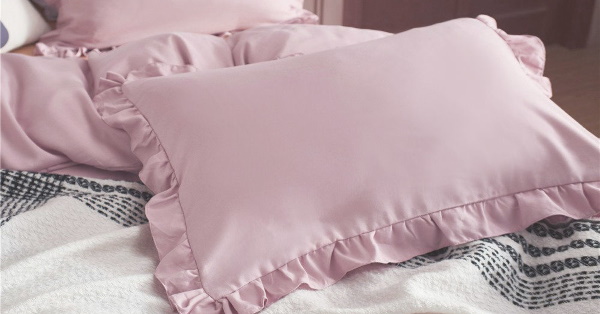
The fabric does not irritate the skin, so it is often used to sew baby bedding and diapers. The disadvantage of calico is the rapid formation of pellets, but they can be easily removed using a special device. Thin fabrics are not suitable for sewing pillowcases for feather pillows. Sharp feathers knock out and cause discomfort when resting.
The table shows the names of other materials suitable for pillowcases and their brief characteristics:
| Textile | Peculiarity |
| Cotton | Resistant to frequent washing and will last longer than chintz. |
| Satin | Smooth shiny fabric, looks beautiful and expensive. |
| Flax | Strong and lightweight, provides coolness in hot weather. |
| Batiste | Does not irritate sensitive skin. |
| Silk | Expensive and beautiful material. |
| Percale | Dense, soft and breathable. |
| Atlas | Shiny, looks expensive, but wrinkles easily. |
| Viscose | Smooth texture with a matte shine. |
| Crepe | Does not require ironing, wear-resistant. |
| Tencel | A budget alternative to silk. |
| Ranforce | Does not form pellets, does not crumble or fade. |
These materials provide a feeling of coolness in the hot season. Pillowcases for winter can be sewn from flannel or terry cloth. They also absorb moisture well, but at the same time heat up quickly and maintain heat. Pillowcases for sleeping can be decorated with soft lace, sewn over the ears. The ears can also be pulled over with threads, making a semblance of petals. This method of decoration is very popular in England. For decorative pillows that will lie on the sofa as decoration, a rough material that is resistant to wear is suitable. Velvet is considered a good option.

The fabric is pleasant to the touch and can last 2-4 years. In stores you can find a shade that suits any interior.
If velvet is too expensive, then it can be replaced with velour. It has a short pile that is pleasant to the touch. Such fabrics need to be well looked after. If there are pets in the house, then the pillows need to be vacuumed or cleaned from hair, as small and light debris easily clings to them. The problem with sticky animal hair can be solved by sewing pillowcases from flock. The material has short pile, but does not electrify and does not cling to debris. In addition, it is very durable, pets will not be able to damage it with their claws.
Another option is chenille. This is a dense fabric with a short pile and an engraved pattern. Chenille is often used for furniture upholstery. Pillows in pillowcases made of this material will hold their shape well, so they can be used as back support while sitting on the sofa.
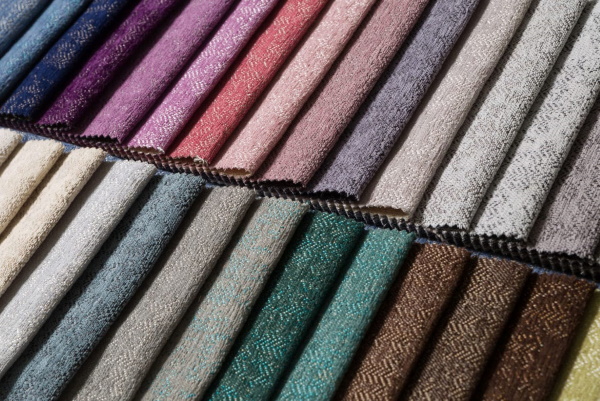
What other fabric is suitable for pillowcases on decorative pillows:
| Textile | Peculiarity |
| Teak | Durable water-repellent material. Suitable for sewing decorative pillowcases for a kitchen sofa. |
| Satin jacquard | Sturdy fabric with printed patterns |
| Jeans | One of the most durable fabrics, holds its shape well |
| Wool | Soft and pleasant to the touch texture |
| Rohozhka | A rough material that looks like burlap. Suitable for a loft-style interior. |
| Micro-velvet | Fabric with short and hard pile |
| Tricovelour | Velour with jersey in the composition. Soft, holds its shape well. |
| Suede | Dense and wear-resistant |
| Scotchgard | Durable material with protective weave underneath |
| Arpatek | Does not fade in the sun and does not shed |
| Eco-leather | Soft PU leather, waterproof and comfortable to touch |
The most popular material is microfiber. This fabric is very soft and pleasant to the touch. You can find any color in stores: plain, with a pattern, from pastel to acid colors. However, microfiber has a couple of disadvantages: it quickly forms pellets, the fabric becomes electrified. Sofa pillowcases can be decorated with rhinestones, beads or voluminous embroidery. You can sew a patchwork product from scraps of fabric of different colors and textures. Tassels made of threads are often sewn onto velvet pillows.
How to calculate fabric consumption?
A pillowcase with ears (you can sew a beautiful product only after correctly calculating the fabric consumption) differs from simple pillowcases by the presence of a wide rim along the seams, the standard width of which is 5-10 cm. This must be taken into account when calculating the material consumption. Having remembered the calculation formula, it will be easier to buy the required amount of fabric for products of other sizes. The most common sizes of both bed and decorative pillows are 70x70 cm and 70x50 cm.

How to calculate:
- To calculate the length of fabric for a 70x70 cm pillowcase, you need to add up the seam allowances (8 cm), the pillow width (70x2 cm), the ear width (7x4 cm) and the length of the pocket or flap (25 cm). All values are conditional. If you calculate, you get: 8 + 140 + 28 + 25 = 201 cm. To calculate the width of the fabric, you need to add up the same parameters, except for the pocket size: 8 + 140 + 28 = 176 cm. Total: to sew a pillowcase with ears 7 cm wide, a 70x70 pillow will require a piece of fabric 201x176 cm.
- Calculation of fabric consumption for pillowcases for 70x50 cm pillows: fabric length = 8 + 140 + 28 + 25 = 201 cm. Fabric width: 8 + 100 + 28 + 25 = 161 cm.
The material should be purchased with a reserve, as some fabrics shrink. Add 4 cm to the results obtained. As a result, for a pillowcase on a 70x70 cm pillow, you will need a piece of 205x180 cm, and for a 70x50 cm pillow, you will need a square measuring 205x165 cm.
Making a pattern for a pillowcase with ears, depending on the size. Step-by-step instructions
To make a pillowcase even and beautiful, you need to construct the pattern correctly. Beginner seamstresses should make markings on cardboard or thick paper, and then transfer them to the fabric.
What tools will you need to create a pattern:
- simple pencil;
- long ruler;
- scissors;
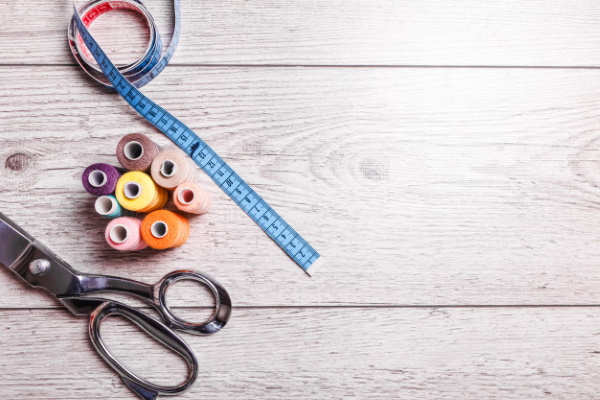
- a piece of soap or chalk;
- textile.
When constructing a pattern, you need to take into account possible shrinkage of the fabric and, in addition to seam allowances, add 2-3 cm to the width of the pillow. The width of the ears needs to be thought out in advance. Usually, the larger the pillowcase, the wider the ears.
50x70
The ears are 5 cm wide. The markings are made on a rectangle of paper or fabric 178 cm long and 56 cm wide.
Step by step instructions:
- From the left edge (56 cm) mark 2.5 cm from the top and bottom. Connect the dots with a vertical line. The fabric will be folded there.
- Step back 70 cm from the line from the top and bottom. Connect the dots with a line.
- Step back from the line and place 2 points 10 cm apart.
- Divide the drawn strip into 2 (5 cm each) with a dotted line. This is the fold line.
- Measure out another 70 cm and draw a line.
- Set aside another 10 cm and divide in half with a dotted line.
- Now put aside 13 cm. This is the width of the pocket.
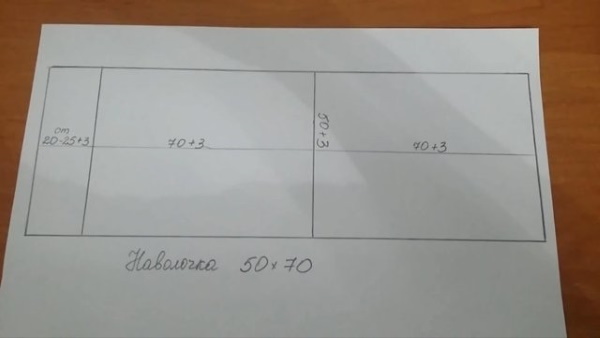
There should be 2.5 cm of free edge left after the last line. There will be a pocket hem there. In this pattern, 3 cm in length and 4 cm in width were allocated for shrinkage.
70x70
The ears are 6 cm wide. You will need a rectangle 194 cm long and 82 cm wide.
Construction of the pattern:
- From the left edge, set aside 3 cm for hems.
- Measure 70 cm and draw a line.
- Next, draw a strip 12 cm wide and divide it into 2.
- Repeat steps 2 and 3.
- Measure 25 cm for the pocket and another 3 cm for the hem.
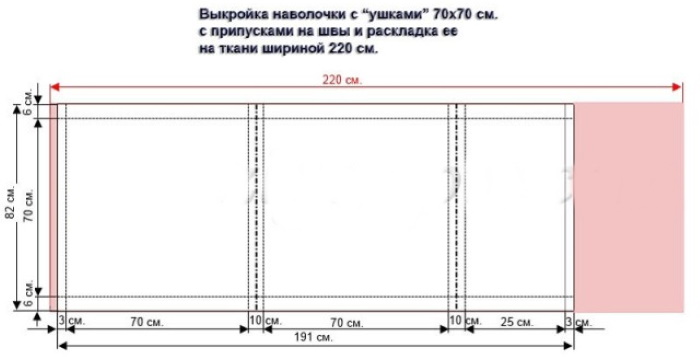
Transfer the pattern from paper to fabric and sew the product.
60x40
The ears are 5 cm wide. You will need a piece of fabric 158 cm long and 46 cm wide.
How to construct a pattern:
- Leave 2.5 cm for the hem.
- Measure 60 cm and draw a vertical line.
- Draw a 10 cm strip and divide it in half with a dotted line.
- Repeat steps 2 and 3.
- Set aside 13 cm for the flap and 2.5 cm for the hem.
This pattern allows for 4 cm of shrinkage.
How to sew a simple pillowcase with "ears"?
Sewing a simple pillowcase with ears according to the pattern previously described in the article, for a pillow measuring 50x70, can be done using step-by-step instructions:
- Transfer the pattern to the front side of the fabric.
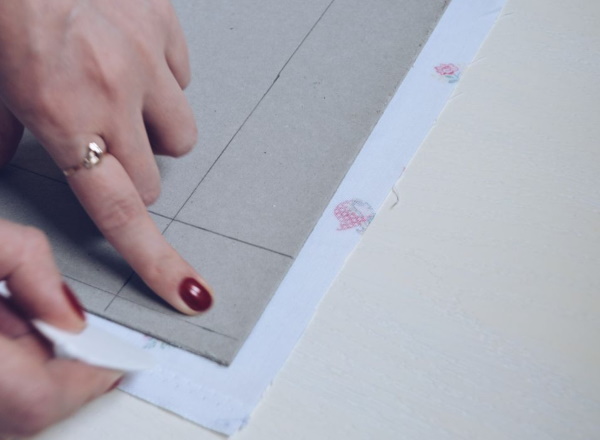
- From the pocket side, fold 2.5 cm along the mark. Iron the fold and stitch.
- Now you need to fold the fabric with the right sides facing each other. 13 and 5 cm, according to the mark. Sew the edges.
- On the opposite side, fold the material by 75 cm. Sew the edges on both sides and finish with a zigzag or overlock stitch.
- Turn the product right side out.
- Sew the pillowcase along the edges so that the ears hold their shape well.
- On each side, set aside 5 cm and draw lines that form a “frame”.
- Sew with a fine stitch.

Wash and iron the pillowcase, then place it on the pillow.
Pattern for a pillowcase with a zipper
A pillowcase with ears (the product can be sewn not only on a sewing machine, but also by hand) with a zipper is a good way to hide the old and no longer attractive color of a decorative pillow.
How to make a pattern for a 45x45 cm pillow with an ear width of 3.5 cm:
- Cut a rectangle of fabric 54 cm wide and 106 cm long.
- From the left edge, step back 1 cm for the zipper.
- Set aside 45 cm, then mark a strip 7 cm wide and divide it in half.
- Repeat the previous point.
There should be another 1 cm left for the zipper.
How to sew a pillowcase with a zipper
To work you will need:
- textile;
- scissors;
- chalk;
- safety pins;
- zipper that matches the color of the fabric.
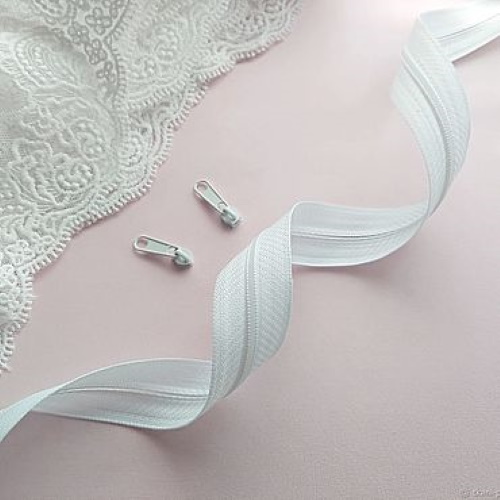
The zipper can be inserted in 2 ways: visible and hidden. In the first case, the color of the zipper should be matched to the main material. The hidden zipper is almost invisible, so it can be darker or lighter than the main shade of the product by 2-3 tones or simply harmonize with the color of the pattern.
The advantage of such a pillowcase is that sometimes it can be used as a pillow base, that is, the filling can be placed directly into the pillowcase, without a pillowcase.
In this case, the fabric should be dense and hold its shape well, and the pillow contents should be soft and light. Feather filling is not suitable, since 1 layer of material is not enough to mask the feathers that are sticking out.
With a regular zipper
How to sew a pillowcase with a simple zipper based on a 60x40 pattern:
- You will need to slightly change the basic pattern. In point 2, set aside 60 cm, and 49.5 cm.
- Next, mark it out as in the description.
- Mark the valve 13 cm.
- Fold the edges along the markings.
- Fold 13 and 5 cm and stitch the edges.
- Fold 54.5 cm from the back side and stitch.
- Sew a zipper between the joining edges, leaving 2.5 cm from the edges on both sides.

- Unzip and turn the product inside out.
- Step back 5 cm from each edge and sew.
The zipper will be on the back of the pillow, so this should be taken into account when choosing a patterned fabric.
With hidden zip fastening
Description of sewing a pillowcase with ears from a pattern measuring 45x45 cm (the construction is described earlier in the article):
- Process the pattern width on an overlock machine.
- Place the fabric right sides together so that the finished edges meet.
- Along the joint line, measure 4 cm inside from the top and bottom. The resulting segment is the place for the zipper.
- Use safety pins to pin the zipper so that the finished edges of the fabric cover the teeth, but do not interfere with the sliding of the puller.
- Sew the zipper with a blind stitch.
- Iron the stitches from the front side.
- Now you need to turn the product inside out and stitch it along the edges, leaving 1 cm on each side.
- Turn the pillowcase inside out through the unzipped zipper.
- Step back 3.5 cm from each edge, draw a square with chalk and sew along the markings.
The pillowcase with a hidden zipper is ready. You can fill it with holofiber or put it on the pillow.
Wrap-around pillowcase pattern
A pillowcase with ears (you can sew the product using an old ripped pillowcase as a template) and with a wrap differs from a regular pillowcase with a pocket only in that the valve is wider. A product sewn according to this cut holds its shape better. It is often used for old pillows that have lost their attractive appearance. Which it is a pity to throw away.
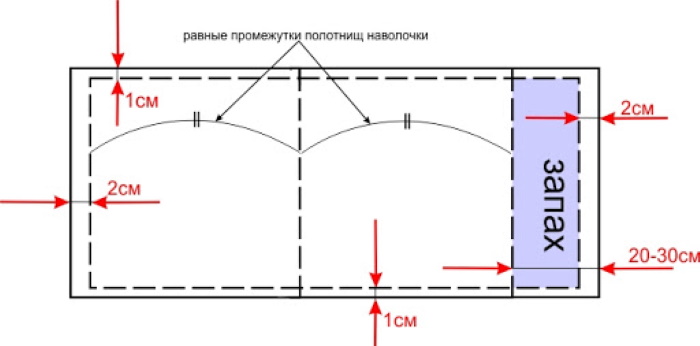
How to make a pattern for a pillow with ears measuring 70x70, ear tire 5 cm, wrap-around model:
- You need a rectangle 200 cm long and 82 cm wide.
- On the left, step back 2.5 cm for the hem.
- Measure out 70 cm and draw a line.
- Step back 10 cm and divide it in half with a dotted line.
- Repeat the previous 2 points.
- Step back 35 cm, draw a line and leave 2.5 cm for the hem.
The wrap should be 2 times smaller than the width of the pillow (70\2=35), this should be taken into account when constructing a pattern for a pillowcase of a different size.
Step-by-step master class on sewing a pillowcase with a wrap
To work you will need:
- iron;
- safety pins;
- ruler;
- washable marker.
How to sew a pillowcase with ears, wrap-around model:
- Overlock all edges.
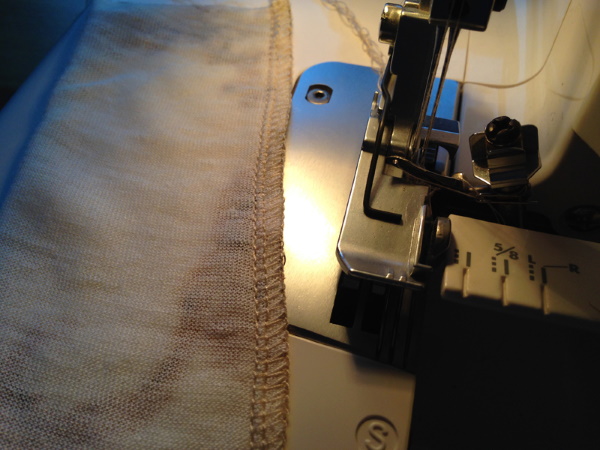
- Fold the sides 2.5 cm along the markings and steam with an iron.
- Turn it over another 2.5 cm, iron it and secure the fold with pins.
- Use a ruler to measure 3 mm from the edge of the fold and mark the dots with a marker for reference.
- Sew with a stitch at medium pitch.
- Lay the material out on the table, turning it inside out.
- Fold the fabric 35 and 5 cm face down and sew along the edges. This will be a deep pocket.
- On the other side, fold the edge by 70 and 5 cm. Sew the edges with a zigzag or process them on an overlock.
- Carefully straighten the product, align all seams.
- Step back 3 mm from each edge and make marks with a marker. Sew with a blind stitch along the marked line so that the ears do not lose their shape.
- Step back 5 cm from each edge and draw a square with a marker. Sew with a small step line along the markings.
A pillowcase with ears (you can sew such a model from any fabric) can be decorated with ribbons in the place of the smell. You need to make holes and process them with a loop stitch or insert eyelets. Thread a satin ribbon of a suitable color through them and tie it with a bow. Sewing a pillowcase with ears with your own hands is easy, the main thing is to correctly construct a pattern, taking into account all the dimensions and properties of the fabric. To check how much the material shrinks, you need to wash a 10x10 cm piece at a water temperature acceptable for the selected type of fabric.
Video on how to sew a pillowcase with ears
Instructions on how to sew a pillowcase with ears:
